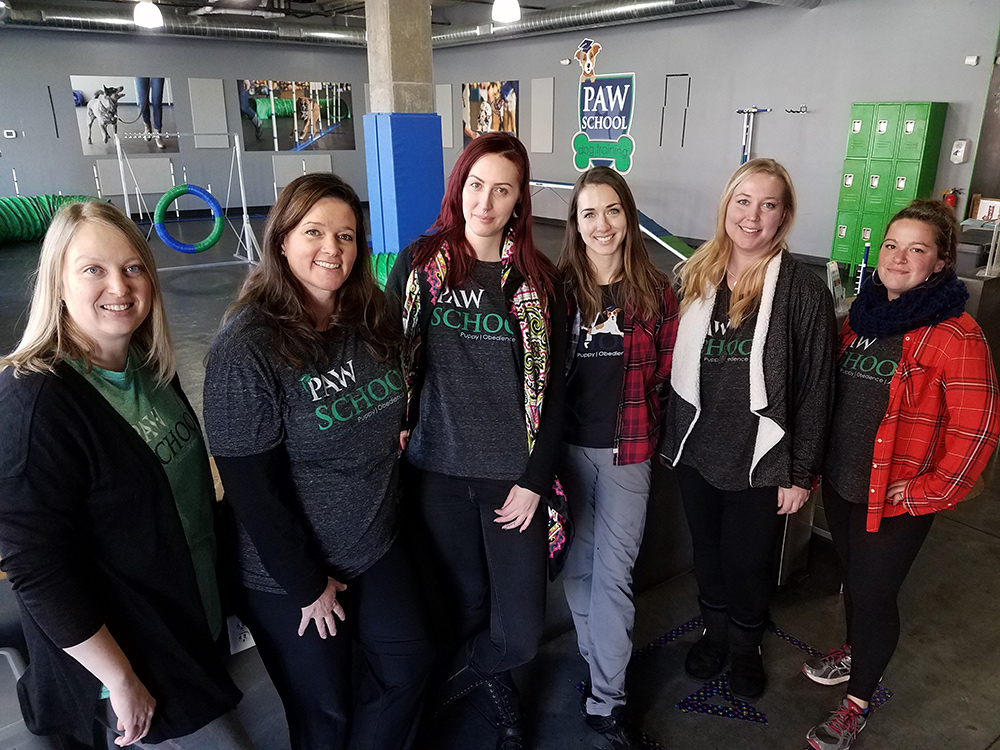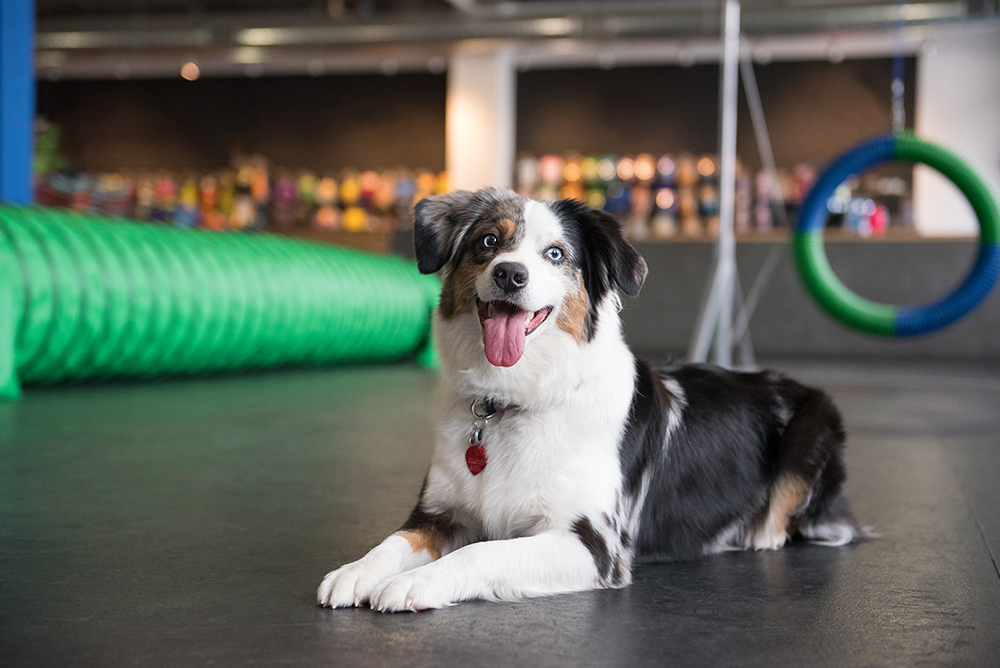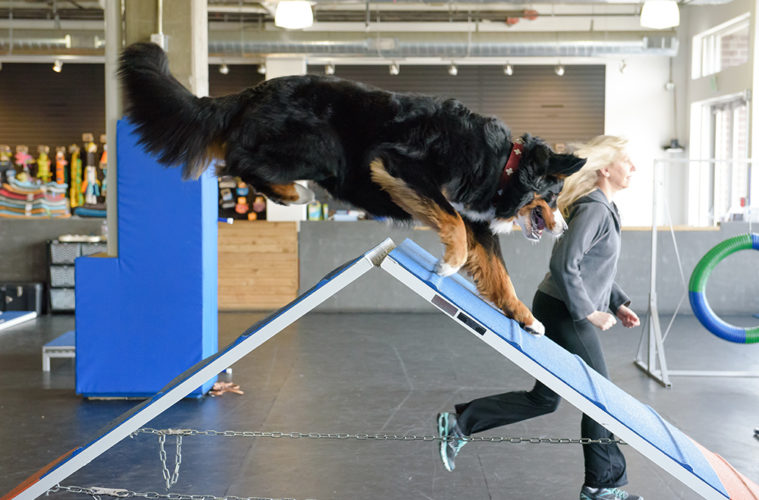BY KATHY HISEY BAUM
It was Sally’s turn. Her challenge was to stay while her owner walked away. No chasing after her. No jumping. And certainly no barking. Sally, a 10-month-old Irish Setter, has wavy auburn hair, chocolate brown eyes, and a long pointed face that resembles a piece of paper rolled into the shape of a cone.
 I was at Paw School, an independent, Colorado-owned dog training business on South Broadway. You might expect to hear the sounds of paws clicking and scratching the ground and barks and yips, but the group was silent except for the trainer giving commands.
I was at Paw School, an independent, Colorado-owned dog training business on South Broadway. You might expect to hear the sounds of paws clicking and scratching the ground and barks and yips, but the group was silent except for the trainer giving commands.
“I can assure you the puppy class is not this calm,” owner Kathy Thorpe said. “This is an advanced class.”
The “Manners 4” class included 11-month-old poodle Emmylou, with curls framing her face like she was wearing a fluffy black cap with earflaps; Katie, a golden retriever with Farah Fawcett feathers of fur; and not one, but two goldendoodles named Rocky. One blonde and the other light brown, they could be fraternal twins and members of the Doobie Brothers band with their shaggy hair and mutton chops.
Sally watched as her owner Kathy Velzen walked out of sight, staying still as she was told to do. Upon return, she was promptly rewarded with a “Good girl!” and a treat. This was Manners 4, after all, and you don’t get to this level by acting like a puppy. Indeed, the dogs in this class are no slouches. Katie is a therapy dog who makes visits to hospital patients and Emmylou is working towards her Canine Good Citizen certificate.
There’s no mistaking Denver’s love for our pups. Take a walk through Wash Park, hike our mountain trails or enjoy a craft brew on a patio on a sunny day and you’ll see human and best friend attached at the leash. The dog-sitting website Rover even named Denver one of the most dog-friendly cities in America.
 To keep us from descending into anarchy at the dog park and to minimize the number of chewed up high heels in our landfills, owners turn to top-notch training programs like Paw School to learn everything from the basics (sit, down and leave it) to more advanced classes (behaving amidst distractions, learning to leash walk instead of leash lead and learning to be a therapy dog).
To keep us from descending into anarchy at the dog park and to minimize the number of chewed up high heels in our landfills, owners turn to top-notch training programs like Paw School to learn everything from the basics (sit, down and leave it) to more advanced classes (behaving amidst distractions, learning to leash walk instead of leash lead and learning to be a therapy dog).
Thorpe opened Paw School in 2012 after leaving a corporate career. “I knew I wanted to do something with animals,” she said. Today, Paw School has about 45 classes a week for puppies and adult dogs in a bright and open training space. About 300 dogs come through each week, with the class sizes kept small to allow for more focused attention. Private lessons are available, too.
It’s not all manners and obedience. Dogs can train on agility equipment like weave poles, a tunnel, dog walk, jumps and teeter totters. Paw School’s agility course is non-competitive, but it’s still some serious play. Agility courses strengthen the bond between the owner and the dog, as well as offer mental and physical stimulation.
“If we miss agility, I can tell Sally is a little harder to manage that week,” said Kathy about her 55-lb puppy.
A dog sport class called Rally is a variation of obedience, requiring dogs and owners to work together through a series of stations. Rally classes help dog and owner develop a strong communication style and work as a team.
Local teenager McKenzie Fellers has been taking her purebred poodle Cesar to Paw School classes since he was a puppy. “I wanted to train him as a therapy dog for community service, but when he was a puppy he was so shy and timid he would just hide behind me,” McKenzie said.
The Paw School trainers are competent at adapting their training techniques to each dog’s unique personality. Cesar has come out of his shell with rally, obedience, therapy and agility classes. Cesar and McKenzie are now a great team, visiting nursing home residents for pets and smiles. “Cesar will go and sit by their wheel chair on command, or touch his nose to their hand. The residents always start telling us about the pets they’ve had.”
Paw School utilizes a training method of positive reinforcement, which is based on treats and rewards to help the dogs make good decisions. “Dogs don’t want to be ‘bad’ or ‘naughty,’” Kathy said. “They want to do what is beneficial for them, and that can easily be what pleases the owner if the right parameters are in place.” This parallels in many ways the psychology of learning for humans (a.k.a. the old carrot or the stick debate).
Dogs aren’t humans, of course. But these happy creatures seemed to be enjoying their carrots, um, treats, pretty well. And just like a kid at the grocery store promised something sweet for being good, after class the dogs eagerly circle metal tables topped with large glass jars full of bones, jumbo tennis balls and other healthy chewable treats, gazes expectantly turned up to their owners as if to say “can I have one, please, please, can I?”
Anyone with a dog will tell you that raising them is a commitment. Puppy owners are like new parents, and need coaching and support from the dog trainers, too. Rocky’s owner Leah Rosenthal said, “I’m doing this as much for me as I am for Rocky. He’s my first dog, and at his size I don’t want him jumping all over people like other dogs I’ve been around in my apartment.” Since Rocky is about as tall as Leah when he stands on two legs, that’s probably not a bad idea.
“We offer the skills and the training in classes with distractions to mimic the real world,” Kathy said, “but success is also dependent on the owner practicing with the dog in between classes.”
Paw School makes a commitment to training easier on the owners by offering a flexible punch-pass type schedule, where you can change the days of your class if you need to miss for travel or work.
To make your dog a standout pupil, visit http://www.denverpawschool.com for hours and training information.

